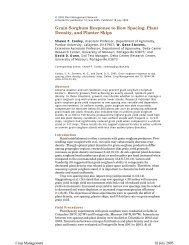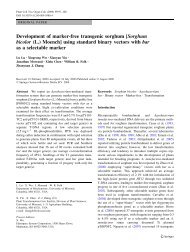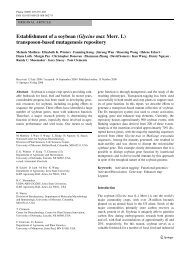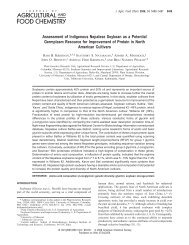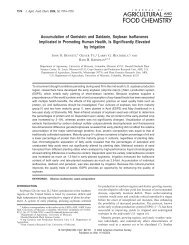Proline Accumulation in Maize (Zea mays L ... - Plant Physiology
Proline Accumulation in Maize (Zea mays L ... - Plant Physiology
Proline Accumulation in Maize (Zea mays L ... - Plant Physiology
Create successful ePaper yourself
Turn your PDF publications into a flip-book with our unique Google optimized e-Paper software.
1350 Verslues and Sharp <strong>Plant</strong> Physiol. Vol. 119, 1999<br />
Previous work <strong>in</strong> our laboratory has focused on mechanisms<br />
of growth ma<strong>in</strong>tenance <strong>in</strong> the maize primary root at<br />
low w . Although root growth is <strong>in</strong>hibited at low w ,itis<br />
much less <strong>in</strong>hibited than shoot growth (Sharp et al., 1988).<br />
Ma<strong>in</strong>tenance of root elongation occurs preferentially toward<br />
the root apex (Sharp et al., 1988), <strong>in</strong> association with<br />
dramatic <strong>in</strong>creases <strong>in</strong> Pro concentration to as much as 120<br />
mmolal at a w of 1.6 MPa (Voetberg and Sharp, 1991).<br />
The accumulation of Pro <strong>in</strong> the apical region was shown to<br />
be largely attributable to an <strong>in</strong>creased net rate of Pro deposition<br />
(Voetberg and Sharp, 1991). In contrast, <strong>in</strong>creased<br />
deposition was not observed for K and hexoses (Sharp et<br />
al., 1990); <strong>in</strong>creases <strong>in</strong> the concentrations of these solutes<br />
occurred primarily <strong>in</strong> the more basal regions of the elongation<br />
zone and could be accounted for by decreased dilution<br />
result<strong>in</strong>g from growth <strong>in</strong>hibition.<br />
The net Pro deposition rates reported by Voetberg and<br />
Sharp (1991) were calculated by comb<strong>in</strong><strong>in</strong>g spatial distributions<br />
of elongation rate and Pro content (see “Materials<br />
and Methods”). Although this analysis demonstrated unambiguously<br />
that more Pro was added to the solute pool <strong>in</strong><br />
the root elongation zone at low w , it could not provide<br />
<strong>in</strong>formation concern<strong>in</strong>g the metabolic processes responsible<br />
for the <strong>in</strong>creased Pro deposition. This <strong>in</strong>crease could be<br />
caused by <strong>in</strong>creased synthesis of Pro <strong>in</strong> the elongation<br />
zone, <strong>in</strong>creased Pro import from other parts of the seedl<strong>in</strong>g,<br />
decreased catabolism or utilization of Pro <strong>in</strong> the elongation<br />
zone, or a comb<strong>in</strong>ation of these factors. In this study, we<br />
assessed the relative importance of these factors by apply<strong>in</strong>g<br />
labeled Pro or the Pro precursors Glu and Orn specifically<br />
to the apical region of <strong>in</strong>tact roots grow<strong>in</strong>g at high or<br />
low w <strong>in</strong> solution culture. Rates of label <strong>in</strong>corporation <strong>in</strong>to<br />
Pro and other am<strong>in</strong>o acids were monitored and used to<br />
assess rates of Pro synthesis, catabolism, and utilization.<br />
The results show that none of these factors was responsible<br />
for Pro accumulation; however, Pro uptake did <strong>in</strong>crease at<br />
low w . Taken together, our results <strong>in</strong>dicate that <strong>in</strong>creased<br />
transport of Pro to the root tip is the major source of Pro<br />
accumulated <strong>in</strong> the root elongation zone at low w .<br />
MATERIALS AND METHODS<br />
Seedl<strong>in</strong>g Culture and Label<strong>in</strong>g<br />
Conditions for maize (<strong>Zea</strong> <strong>mays</strong> L. cv FR27 FRMo17)<br />
seed germ<strong>in</strong>ation, transplant<strong>in</strong>g to solution culture, low w<br />
imposition, and seedl<strong>in</strong>g growth were as described by<br />
Verslues et al. (1998). Two w treatments were used: high<br />
w (0.02 MPa, no PEG added) and low w (1.6 MPa<br />
PEG). In both treatments, supplemental oxygenation was<br />
provided to <strong>in</strong>crease the solution oxygen partial pressure<br />
from 20.4 (ambient) to 43 kPa, at which level tissue oxygen<br />
partial pressure with<strong>in</strong> the root elongation zone was shown<br />
to be similar to that <strong>in</strong> roots grow<strong>in</strong>g <strong>in</strong> well-aerated vermiculite<br />
(Verslues et al., 1998). Clear plastic root guides<br />
were used to prevent damage from the vigorous aeration<br />
and to hold the roots <strong>in</strong> position for spatial growth analysis<br />
and label<strong>in</strong>g. In the low- w treatment, the solution w was<br />
reduced to 1.6 MPa over approximately 10 h by pump<strong>in</strong>g<br />
PEG solution <strong>in</strong>to the solution-culture box. The boxes, each<br />
conta<strong>in</strong><strong>in</strong>g 23 seedl<strong>in</strong>gs, were essentially the same as those<br />
described by Verslues et al. (1998).<br />
After transfer to solution culture, the seedl<strong>in</strong>gs were<br />
allowed to grow for approximately 32 h <strong>in</strong> the high- w<br />
treatment and for 52 h <strong>in</strong> the low- w treatment. At these<br />
times, root elongation rates (measured by monitor<strong>in</strong>g the<br />
position of the root apex on the side of the box) and root-tip<br />
am<strong>in</strong>o acid concentrations were steady (see “Results”).<br />
Average primary root lengths were approximately 150 mm<br />
at high w and 115 mm at low w ; seedl<strong>in</strong>gs with primary<br />
roots that were substantially shorter or longer than this<br />
were removed from the box. Sixteen seedl<strong>in</strong>gs were left <strong>in</strong><br />
the box and were height adjusted so that their primary root<br />
apices were all the same distance (1 mm) from the bottom<br />
of the box. Height adjustments were made by gently lift<strong>in</strong>g<br />
the caryopsis of each seedl<strong>in</strong>g and support<strong>in</strong>g it us<strong>in</strong>g a<br />
toothpick <strong>in</strong>serted <strong>in</strong>to a Plexiglas pegboard. The solution<br />
<strong>in</strong> the box was then dra<strong>in</strong>ed until only the apical 12 to 15<br />
mm of each primary root rema<strong>in</strong>ed submerged. The aeration<br />
rate was reduced to 550 mL m<strong>in</strong> 1 to avoid excessive<br />
splash<strong>in</strong>g of the solution onto more basal parts of the roots,<br />
and the seedl<strong>in</strong>gs were allowed to acclimate to these conditions<br />
for approximately 15 m<strong>in</strong>.<br />
To label the root apical region, 20 Ci of 3 H-labeled Glu<br />
or Pro or 9 Ci of 14 C-labeled Orn was added to a 25-mL<br />
aliquot of solution removed from the root box (l-[2,3,4-<br />
3 H]Glu, 60 Ci mmol 1 ; l-[3,4- 3 H]Pro, 40 Ci mmol 1 ; and<br />
l-[1- 14 C]Orn, 50 mCi mmol 1 ; American Radiolabeled<br />
Chemicals, St. Louis, MO; a specific activity of 40 Ci<br />
mmol 1 is equivalent to 8.8 10 7 dpm nmol 1 ). This<br />
resulted <strong>in</strong> the follow<strong>in</strong>g am<strong>in</strong>o acid concentrations <strong>in</strong> the<br />
label<strong>in</strong>g solution: Glu, 1.3 10 5 mm; Pro, 2.0 10 5 mm;<br />
and Orn, 7.2 10 3 mm. The solution conta<strong>in</strong><strong>in</strong>g labeled<br />
am<strong>in</strong>o acid was put <strong>in</strong>to a second root box (the “label<strong>in</strong>g<br />
box”), and the Plexiglas holder conta<strong>in</strong><strong>in</strong>g the heightadjusted<br />
seedl<strong>in</strong>gs was then transferred to the label<strong>in</strong>g box,<br />
which was configured so that the 25 mL of label<strong>in</strong>g solution<br />
covered the apical 12 to 15 mm of each primary root.<br />
Total aeration rate <strong>in</strong> the label<strong>in</strong>g box was kept at 550 mL<br />
m<strong>in</strong> 1 .<br />
Sections of four primary roots were collected 10, 30, 60,<br />
and 120 m<strong>in</strong> after transfer of seedl<strong>in</strong>gs to the label<strong>in</strong>g box.<br />
At each sampl<strong>in</strong>g time, four seedl<strong>in</strong>gs were removed from<br />
the box and their root tips submerged for 3 m<strong>in</strong> <strong>in</strong> an<br />
ice-cold aliquot of growth medium of the same w as that<br />
<strong>in</strong> the box. This allowed efflux of labeled am<strong>in</strong>o acids that<br />
had entered the root apoplast but had not yet been taken<br />
up by root cells. Three m<strong>in</strong>utes was chosen because prelim<strong>in</strong>ary<br />
experiments showed that there was a rapid efflux<br />
of radioactivity from the root for 3 m<strong>in</strong>, which was followed<br />
by a slower, steady efflux, presumably from the<br />
symplast (data not shown). The seedl<strong>in</strong>gs were then removed<br />
and blotted dry. After excision of the apical 0.5 mm<br />
to remove the majority of the root cap, root sections were<br />
collected us<strong>in</strong>g a razor-blade holder with the razor blades<br />
adjusted to correspond to the positions shown <strong>in</strong> Figure 1.<br />
The sections were placed <strong>in</strong> preweighed microcentrifuge<br />
vials and immediately frozen <strong>in</strong> liquid nitrogen. Samples<br />
were then weighed, freeze dried, and reweighed to obta<strong>in</strong><br />
the weight of water by difference.



